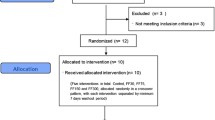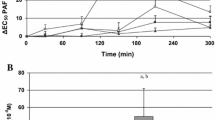Abstract
Purpose
Blood orange juice (OJ) is an important source of anthocyanins (ACN). The latter molecules are endowed with antioxidant activity and might thus modulate different cell function. Our aim was to investigate ACN absorption following a 1-month daily supplementation of blood OJ and their potential effects on cell markers of platelet and leukocyte activation and interaction.
Methods
Eighteen healthy subjects (10 men and 8 women) were supplemented for 4 weeks with 1 L/day of either blood OJ or blond OJ (that contains no ACN), following a cross-over design. Blood samples were obtained from fasting participants both at baseline and after each week of treatment to measure plasma ACN concentration. At the same time-intervals, 24-h urinary excretion of these molecules was also measured. At the beginning and the end of each 4-week intervention period, platelet and leukocyte markers and mixed cell conjugates were assessed both in basal condition and upon in vitro collagen/ADP activation.
Results
After 1 week supplementation with blood OJ, 24-h urinary excretion of ACN reached average levels of 11.47 ± 5.63 nmol that significantly differed from baseline and remained substantially unchanged until the end of treatment. No plasma accumulation of ACN following blood OJ supplementation was observed. Cellular markers were not significantly affected by either OJ after 4-week supplementation.
Conclusions
Following supplementation of healthy volunteers with 1 L/day of blood OJ for 4 weeks, the ACN plasma levels reached were insufficient to significantly modify cell markers of platelet and leukocyte activation and interaction.


Similar content being viewed by others
References
Chun OK, Chung SJ, Song WO (2007) Estimated dietary flavonoid intake and major food sources of U.S. adults. J Nutr 137:1244–1252
Wu X, Beecher GR, Holden JM, Haytowitz DB, Gebhardt SE, Prior RL (2006) Concentration of anthocyanins in common foods in the United States and estimation of normal consumption. J Agric Food Chem 54:4069–4075
Kunhau J (1976) The flavonoids. A class of semi-essential food components: their role in human nutrition. World Rev Nutr Diet 24:117–191
Gasiorowski K, Szyba K, Brokos B, Kolaczynska B, Jankowiak-Wlodarczyk M, Oszmianski J (1997) Antimutagenic activity of anthocyanins isolated from aronia melanocarpa fruits. Cancer Lett 119:37–46
Youdim KA, Martin A, Joseph JA (2000) Incorporation of the elderberry anthocyanins by endothelial cells increases protection against oxidative stress. Free Rad Biol Med 29:51–60
Youdim KA, McDonald J, Kalt W, Joseph JA (2002) Potential role of dietary flavonoids in reducing microvascular endothelium vulnerability to oxidative and inflammatory insult. J Nutr Biochem 13:282–288
Rechner AR, Kroner C (2005) Anthocyanins and colonic metabolites of dietary polyphenols inhibit platelet function. Thromb Res 116:327–334
Mink PJ, Scrafford CG, Barraj LM, Harnack L, Hong CP, Nettleton JA, Jacobs DR Jr (2007) Flavonoid intake and cardiovascular disease mortality: a prospective study in postmenopausal women. Am J Clin Nutr 85:895–909
Cerletti C, de Gaetano G, Lorenzet R (2010) Platelet-leukocyte interactions: multiple links between inflammation, blood coagulation and vascular risk. Mediterr J Hematol Infect Dis 2:e2010023
Folts JD, Demrow HS, Slane PR (1994) Two glasses of red wine but not white wine inhibit ex vivo platelet aggregation and increase bleeding time in humans. J Am Coll Cardiol 66A:Abstract
Keevil JG, Osman HE, Reed JD, Folts JD (2000) Grape juice, but not orange juice or grapefruit juice inhibits human platelets aggregation. J Nutr 130:53–56
Maccarone E, Rapisarda P, Fanella F, Arena E, Mondello L (1998) Cyanidin-3-(6″-malonyl)-β-glucoside. One of the major anthocyanins in blood orange juice. Ital J Food Sci 10:367–372
Dugo P, Mondello L, Morabito D, Dugo G (2003) Characterization of the anthocyanin fraction of Sicilian blood orange juice by micro-HPLC-ESI/MS. J Agric Food Chem 51:1173–1176
Hillebrand S, Schwarz M, Winterhalter P (2004) Characterization of anthocyanins and pyranoanthocyanins from blood orange [Citrus sinensis (L.) Osbeck] juice. J Agric Food Chem 52:7331–7338
Rapisarda P, Tomaino A, Lo CR, Bonina F, de Pasquale A, Saija A (1999) Antioxidant effectiveness as influenced by phenolic content of fresh orange juices. J Agric Food Chem 47:4718–4723
Fiore A, La Fauci L, Cervellati R, Guerra MC, Speroni E, Costa S, Galvano G, De Lorenzo A, Bacchelli V, Fogliano V, Galvano F (2005) Antioxidant activity of pasteurized and sterilized commercial red orange juices. Mol Nutr Food Res 49:1129–1135
Vitaglione P, Donnarumma G, Napolitano A, Galvano F, Gallo A, Scalfi L, Fogliano V (2007) Protocatechuic acid is the major human metabolite of cyanidin-glucosides. J Nutr 137:2043–2048
Rapisarda P, Fanella F, Maccarone E (2000) Reliability of analytical methods for determining anthocyanins in blood orange juices. J Agric Food Chem 48:2249–2252
Giordano L, Coletta W, Rapisarda P, Donati MB, Rotilio D (2007) Development and validation of an LC-MS/MS analysis for simultaneous determination of delphinidin-3-glucoside, cyanidin-3-glucoside and cyanidin-3-(6-malonylglucoside) in human plasma and urine after blood orange juice administration. J Sep Sci 30:3127–3136
Maugeri N, Donati MB, de Gaetano G, Cerletti C (2007) Formation of mixed platelet-PMN leukocyte aggregates in the platelet function analyzer (PFA-100) device. Thromb Haemost 97:156–157
Izzi B, Pampuch A, Costanzo S, Vohnout B, Iacoviello L, Cerletti C, de Gaetano G (2007) Determinants of platelet conjugate formation with polymorphonuclear leukocytes or monocytes in whole blood. Thromb Haemost 98:1276–1284
Prior RL (2003) Fruits and vegetables in the prevention of cellular oxidative damage. Am J Clin Nutr 78:570S–578S
Wu X, Cao G, Prior RL (2002) Absorption and metabolism of anthocyanins in human subjects following consumption of elderberry or blueberry. J Nutr 132:1865–1871
Kay CD, Mazza G, Holub BJ (2005) Anthocyanins exist in the circulation primarily as metabolites in adult men. J Nutr 135:2582–2588
Felgines C, Talavera S, Texier O, Gil-Izquierdo A, Lamaison JL, Remesy C (2005) Blackberry anthocyanins are mainly recovered from urine as methylated and glucuronidated conjugates in humans. J Agric Food Chem 53:7721–7727
Felgines C, Talavera S, Gonthier MP, Texier O, Scalbert A, Lamaison JL, Remesy C (2003) Strawberry anthocyanins are recovered in urine as glucuro- and sulfo-conjugated in humans. J Nutr 133:1296–1301
Bub A, Watzl B, Blockhaus M, Briviba K, Liegibel U, Müller H, Pool-Zobel BL, Rechkemmer G (2003) Fruit juice consumption modulates antioxidative status, immune status and DNA damage. J Nutr Biochem 14:90–98
Duthie SJ, Jenkinson AM, Crozier A, Mullen W, Pirie L, Kyle J, Yap LS, Christen P, Duthie GG (2006) The effects of cranberry juice consumption on antioxidant status and biomarkers relating to heart disease and cancer in healthy human volunteers. Eur J Nutr 45:113–122
Curtis PJ, Kroon PA, Hollands WJ, Walls R, Jenkins G, Kay CD, Cassidy A (2009) Cardiovascular disease risk biomarkers and liver and kidney functions are not altered in postmenopausal women after ingesting an elderberry extract rich in anthocyanins for 12 weeks. J Nutr 139:2266–2271
Riso P, Visioli F, Gardana C, Grande S, Brusamolino A, Galvano F, Galvano G, Porrini M (2005) Effects of blood orange juice intake on antioxidant bioavailability and on different markers related to oxidative stress. J Agric Food Chem 53:941–947
Acknowledgments
This work was supported by the 6th EU Framework Program (FLORA Contract no. FOOD-CT-01730). The authors wish to thank Dr. Augusto Di Castelnuovo of Research Laboratories of Catholic University of Campobasso for his valid statistic support.
Conflict of interest
The authors declare that they have no conflict of interest.
Author information
Authors and Affiliations
Corresponding author
Rights and permissions
About this article
Cite this article
Giordano, L., Coletta, W., Tamburrelli, C. et al. Four-week ingestion of blood orange juice results in measurable anthocyanin urinary levels but does not affect cellular markers related to cardiovascular risk: a randomized cross-over study in healthy volunteers. Eur J Nutr 51, 541–548 (2012). https://doi.org/10.1007/s00394-011-0237-9
Received:
Accepted:
Published:
Issue Date:
DOI: https://doi.org/10.1007/s00394-011-0237-9




